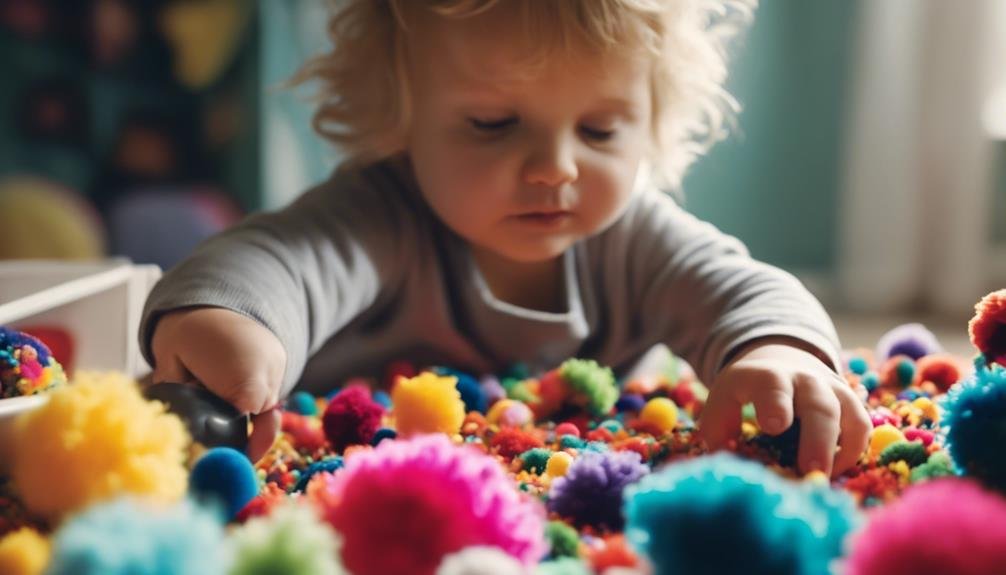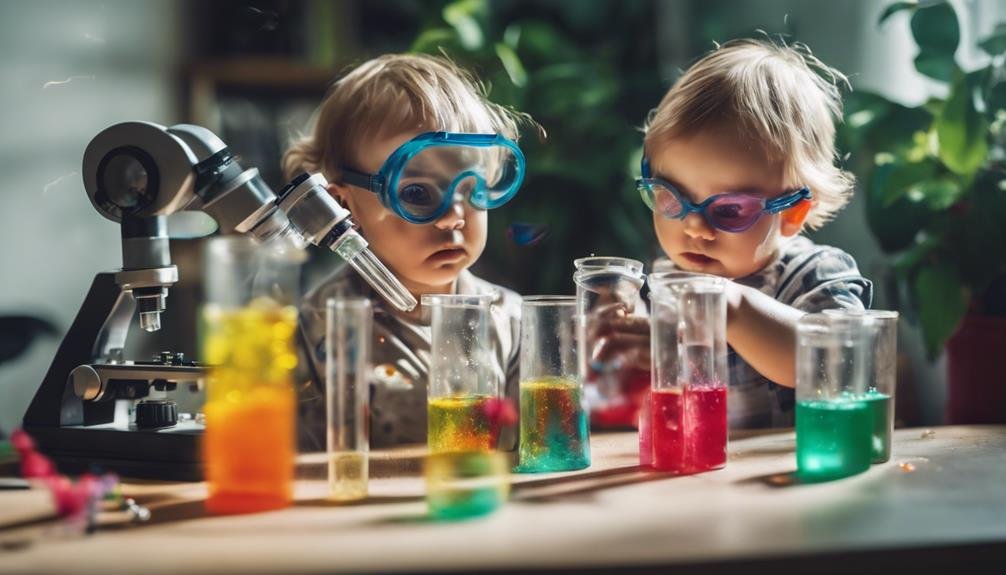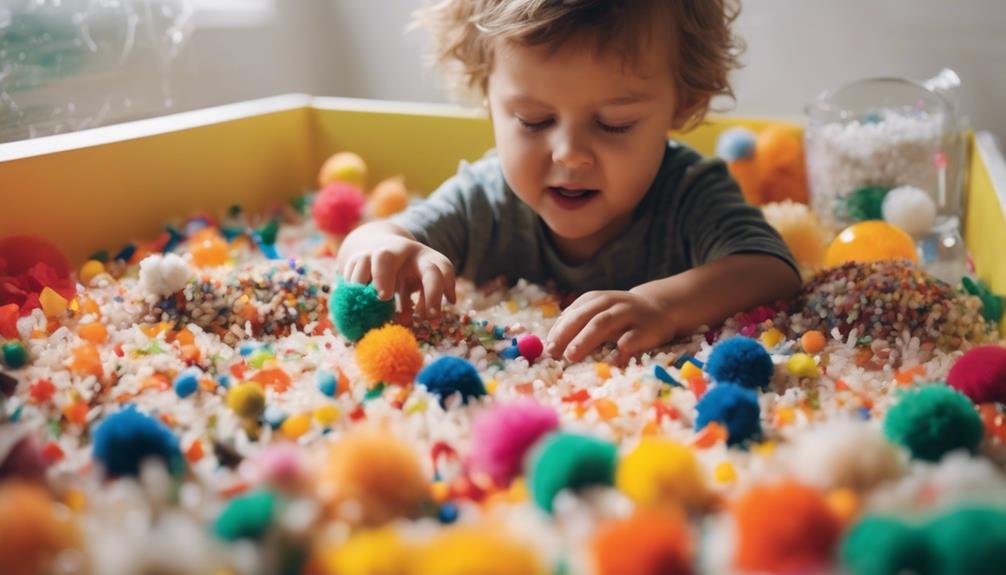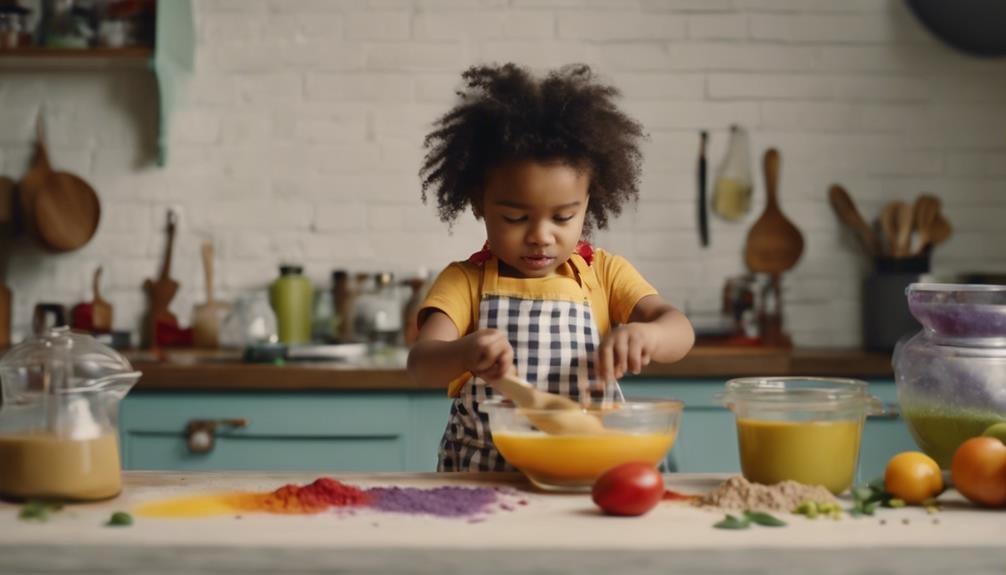"Cherishing Little Steps - A Haven for Baby and Family Journeys"
Indoor Educational Activities for Toddlers: Learning Fun for Every Day
In the hustle and bustle of daily life with a toddler, finding the balance between entertainment and education can be a challenge. However, by incorporating indoor educational activities into your routine, you can make learning a seamless part of your child's day. From simple sensory play ideas to more structured activities like shape and color recognition games, there are numerous ways to engage your little one's curious mind and foster their development. But what about the benefits beyond just learning new skills?
Key Takeaways
- Sensory play with various textures and materials for hands-on learning experiences.
- Engage in creative arts and crafts to foster fine motor skills and creativity.
- Music and movement activities to spark creativity and physical coordination.
- Interactive storytime sessions with props and participation for immersive experiences.
- Conduct simple science experiments at home to engage curiosity and learning.
Sensory Play Ideas

Engage your toddler's senses with a variety of hands-on sensory play ideas that foster learning and exploration. Sensory bins are a fantastic way to introduce different textures, colors, and materials to your little one. Fill a bin with rice, beans, or even water beads, and watch as your toddler explores the different sensations. You can add cups, spoons, and small toys to enhance the experience.
Another engaging activity is creating a sensory board. Use materials like sandpaper, faux fur, bubble wrap, and fabric to create a tactile wonderland for your child. Let them touch and feel the various textures, describing each one as they explore. This not only stimulates their sense of touch but also builds their vocabulary.
Get messy with sensory art activities like finger painting or exploring with shaving cream. These activities not only engage their sense of touch but also encourage creativity and self-expression. Remember to always supervise your child during sensory play to ensure a safe and enjoyable experience.
Creative Arts & Crafts
Let's now explore the world of Creative Arts & Crafts, where your toddler can unleash their imagination and creativity through fun and hands-on activities. Engaging in arts and crafts not only fosters creativity but also enhances fine motor skills and cognitive development.
Here are some ideas to get you started:
- Finger Painting: Dive into the world of colors and textures with finger painting. Let your little one create masterpieces using their hands and explore the joy of mixing different colors.
- Collage Making: Collect magazines, colored paper, and stickers for a collage-making session. Encourage your toddler to create a unique piece by sticking different materials together.
- Playdough Fun: Mold, shape, and squish playdough to enhance sensory experiences and hand-eye coordination. Get creative with various tools to create different shapes.
- Nature Crafts: Go on a nature hunt to gather leaves, twigs, and flowers to create beautiful crafts. Build a nature-inspired masterpiece together and appreciate the beauty of the outdoors.
Music & Movement Activities

Explore the rhythmic world of music and movement with your toddler, sparking their creativity and physical coordination through interactive activities. Dance along to lively tunes, encouraging your little one to move their body in different ways. Use simple instruments like shakers or drums to introduce your child to various sounds and rhythms, fostering a love for music from an early age.
Create a mini music band with household items like pots and pans, wooden spoons, and plastic containers. Let your toddler experiment with making different sounds and rhythms, exploring the concept of cause and effect through music. You can also play freeze dance, where you stop and start the music, prompting your child to freeze or dance around accordingly.
Engaging in music and movement activities not only brings joy and laughter but also supports your toddler's cognitive and physical development. So, put on some music, let loose, and enjoy the magical world of rhythm and movement with your little one!
Interactive Storytime Sessions
Immerse your toddler in an enchanting world of stories and adventures with interactive storytime sessions. These sessions aren't only fun but also incredibly beneficial for your child's development.
Here are some tips to make your interactive storytime sessions engaging and educational:
- Use Props: Bring the story to life by incorporating props like puppets or toys related to the tale.
- Encourage Participation: Ask questions, use different voices for characters, and encourage your toddler to join in the storytelling.
- Act Out Scenes: Act out parts of the story together to make it more interactive and memorable.
- Explore Different Genres: Introduce a variety of stories from different genres to broaden your toddler's exposure to diverse themes and styles.
Science Experiments at Home

Engage your toddler's curiosity and spark a love for science with simple and exciting experiments you can conduct right at home. Try the classic baking soda and vinegar volcano for a bubbly reaction that will amaze your little one. Or fill a jar with water, add some oil and food coloring, then drop in an effervescent tablet to create a mesmerizing lava lamp effect. Watching colors swirl and mix isn't just fun, it's a hands-on way to learn about density and chemical reactions.
Another easy experiment is to fill a bowl with milk, add drops of food coloring, then dip a cotton swab with dish soap to watch the colors dance and swirl. This introduces concepts of surface tension and molecular movement in a playful way. You could even explore how plants drink water by placing white flowers in colored water and observing how the petals change. Encourage questions, make predictions, and most importantly, have fun exploring the wonders of science together!
Indoor Treasure Hunts
Ready to embark on an exciting indoor adventure that will have your little one filled with joy and curiosity? Indoor treasure hunts are a fantastic way to engage your toddler's senses, promote critical thinking, and create lasting memories together.
Here's how you can create a magical treasure hunt experience right in your own home:
- Map it Out: Draw a simple map of your home, marking where the treasures are hidden. This not only adds excitement but also helps your toddler develop spatial awareness.
- Clue Cards: Write or draw clues on colorful cards that guide your little one from one treasure to the next. This encourages problem-solving skills and boosts creativity.
- Treasure Trove: Hide small treats or toys as treasures to be discovered. The thrill of finding hidden gems will keep your toddler engaged and motivated.
- Celebrate Success: End the treasure hunt with a celebration! Whether it's a dance party or a mini tea party with the found treasures, make sure to celebrate the adventure together.
Get ready for an indoor treasure hunt full of laughter, exploration, and cherished moments with your little explorer!
DIY Sensory Bins

Discover the endless possibilities of sensory exploration with simple and creative DIY sensory bins for your toddler. Sensory bins are a fantastic way to engage your little one's senses while promoting cognitive development. You can easily create sensory bins using items you already have at home, making it a budget-friendly activity that provides hours of entertainment.
Here's a fun and interactive DIY sensory bin idea for you to try:
| Sensory Bin Theme | Materials Needed |
|---|---|
| Ocean Adventure | Blue rice, seashells, toy fish, small bucket |
To create the ocean adventure sensory bin, simply dye some uncooked rice blue using food coloring, then add seashells, toy fish, and a small bucket for scooping. Watch as your toddler explores the textured rice, discovers hidden treasures, and engages in imaginative play.
DIY sensory bins are not only entertaining but also help enhance your toddler's sensory processing skills and creativity. So, gather your materials and dive into a world of sensory fun with your little one!
Shape and Color Recognition Games
Get your toddler excited about learning with shape and color recognition games that are both educational and fun.
- Shape Hunt: Encourage your little one to find objects around the house that match different shapes like circles, squares, and triangles.
- Color Sorting: Grab a bunch of colorful objects and help your toddler sort them into different color groups.
- DIY Color Scavenger Hunt: Create a list of colors and have your child find objects of each color around the house.
- Shape Match: Cut out different shapes from colored paper and have your toddler match them together based on shape and color.
These interactive games not only help your child recognize shapes and colors but also enhance their cognitive skills in a playful manner.
Watch as your toddler's eyes light up with joy and accomplishment as they successfully complete each game!
Cooking and Baking Together

Let's dive into the delightful world of cooking and baking together with your little one, creating tasty treats while bonding and learning new skills in the kitchen. Cooking with toddlers can be a messy but incredibly rewarding experience. Engage your child by letting them help mix ingredients, pour, and decorate. These activities enhance their fine motor skills and creativity. Simple recipes like no-bake cookies, fruit kebabs, or homemade pizzas are perfect for tiny hands to assist with.
As you cook together, talk about the ingredients, their colors, textures, and tastes. This not only boosts their vocabulary but also introduces them to basic cooking concepts. Let them smell the vanilla, feel the flour, or taste the sweetness of honey. These sensory experiences are invaluable for their development.
Through cooking and baking, your child learns patience, following instructions, and the joy of creating something from scratch. Don't worry about the mess; it's all part of the fun. So, put on your aprons, tie up those hair, and get ready for a delicious adventure in the heart of your home!
Frequently Asked Questions
How Can I Incorporate Technology Into Indoor Educational Activities for Toddlers?
Want to add tech to your toddler's learning? Try interactive apps, educational videos, or kid-friendly websites. Supervise screen time, choose age-appropriate content, and balance with hands-on activities. Tech can enhance their educational experience!
What Are Some Tips for Managing Multiple Toddlers During These Activities?
When managing multiple toddlers during activities, prioritize safety, engagement, and communication. Encourage teamwork, establish clear rules, and use positive reinforcement. Stay flexible, be patient, and remember to have fun together. Your attentiveness and guidance will create a harmonious learning environment.
Are There Any Specific Resources or Apps That Can Enhance These Activities?
Looking for resources or apps to boost your toddler's indoor learning fun? Explore interactive apps like ABCmouse, Khan Academy Kids, and PBS Kids Games. These engaging tools can enhance their educational activities and keep them entertained!
How Can I Adapt These Activities for Toddlers With Special Needs?
When adapting activities for toddlers with special needs, it's essential to personalize the experience. Focus on their strengths and interests, modify tasks as needed, and provide extra support. Remember, every child is unique, and you're their best advocate.
Can These Activities Be Used for Homeschooling Purposes as Well?
Absolutely! You can totally use these activities for homeschooling. They're great for teaching little ones in a fun way. It's amazing how much learning can happen through play. Give it a try!
Conclusion
As you wrap up your indoor educational activities with your toddler, remember that each moment spent learning and growing together is like planting a seed. Nurture that seed with love, creativity, and curiosity, and watch it blossom into a beautiful flower of knowledge and skills.
Keep exploring, playing, and discovering new ways to spark your child's imagination and foster their development. The world is your playground, so let your little one's potential bloom and flourish.


